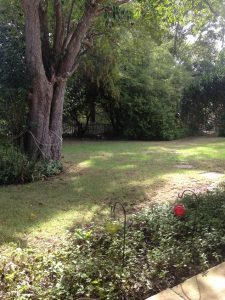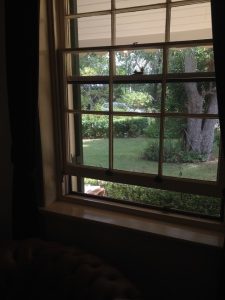
The very first occupant of historic homestead Denfield on Appin Road was John Farley – the man who saw Fred Fisher’s ghost way back in 1826.
Lawyer Patrick Duffy, the current occupant of the 179 year old sandstone brick homestead, doesn’t have anywhere near that kind of notoriety.
He just gets asked if he shares a house with a ghost.
Legend has it the ghost is supposed to be Charlotte, the wife of the second occupant of Denfield, 1850s Campbelltown magistrate John Bray.
“That’s what you get asked: is it haunted,’’ says Duffy.
“No, I haven’t seen a ghost or felt the presence of one since moving in just under two years ago,’’ he says.
[social_quote duplicate=”no” align=”default”]“But we had a party and there was medium among the guests and she said she felt a presence.[/social_quote]
“And Uncle Ivan Wellington, a local Aboriginal elder, a friend of mine, he said that he felt a presence here as well.’’
♦ But ghost or no ghost why would you want to live in an ancient house in the first place?
“I’ve always thought in coming back from Sydney to Campbelltown one of the opportunities was to buy a historic property,’’ says Duffy.
“My first degree was in Australian history and I’ve always been interested in it.
“People think of Campbelltown as a new area.
“And we’re not.
“We’re among the most historic and storied areas in the colonies or what used to be the colonies.
“And it’ an underappreciated part of what it means to be someone from Campbelltown – a son or daughter of Campbelltown – and it’s something I have always had a real connection to,’’ Duffy explains.

It is obvious half an hour after arriving at Denfield that becoming its latest occupant has reignited Patrick Duffy’s interest in the history of Campbelltown.
“Moving in to live here has been everything that I expected, in the sense that people are very interested in Denfield’s history, which is Campbelltown’s history in many ways,’’ he says.
Duffy may be interested in heritage but he describes himself as a “very amateur historian’’.
“There are people out there who are genuine experts at these things, and I’ve only scratched the surface.
“As we get older we realise how little we know and it really is an interesting field, history.
“Many lives were lived here in Denfield in times past and as they say the past is another country.
“But it’s not as foreign as you might think.
“In fact, the continuity you get from places like Denfield shows that the past was not that different in many ways.’’
♦ John Farley built Denfield in 1837 on the highest point of a sprawling 325 acre property with magnificent 360 degree views.
The house was built of sandstone brick on stone footings with stone flagged verandahs.
The kitchen was detached to reduce the risk of any kitchen fires spreading and was linked to the main house by an open “breezeway” with a flagged stone pathway.
Denfield was typical of the colonial homesteads of the time with a wide central hallway and bedrooms running off the hall and a lounge/sitting room with an open fireplace and marble mantlepiece.
Three years later Farley sold Denfield to the Brays.
John Bray was appointed magistrate in Campbelltown in 1852 and Denfield stayed in the Bray family for almost 80 years.
In 1917 it was passed to a family called Hickey, who leased it to the Carrolls.
Eventually the house was neglected and became derelict by 1963.
Fatefully, a year or so later it was restored to its original glory and Patrick Duffy has the photos to prove it.
“After I moved in a former owner dropped in and gave me a photographic record of the restoration that was done at Denfield.

“Without the restoration, this would be another statistic, like all the ones we had but which are no longer here in Campbelltown,’’ Duffy says.
“We had the beautiful Federal Hotel, which became Lack’s, we had so many other historic buildings in Queen Street, in Allman Street, in Lithgow Street.
“Campbelltown was a beautiful, classic Australian town, and one of the reasons it’s no longer that is that even art deco places like the Good Intent Hotel, built in 1939, were simply disposed of without ceremony.
“In terms of historic buildings here we do have a very poor track record.’’
♦ Buying Denfield and living in it has not just refreshed Patric Duffy’s heritage instincts – it has also brought him physically back close to where he grew up.
“My mother still lives there, in Campbellfield Avenue, just over the hill,’’ he says pointing north towards Bradbury.
Like many other people, his mum and dad moved to Campbelltown in the 1960s to start a new life among the gum trees surrounding the brand new housing estates.
Patrick was born in 1971 and says he has vivid memories of what a great time he had growing up here.
He attended St John the Evangelist, bounded by Cordeaux and Lindesay and Lithgow Streets.
Then it was six years at Hurlstone Agricultural High School before heading off to university and law school.
“Me and my brother caught the bus to primary school, it was called the Macquarie Heights bus,’’ he recalls.
“Macquarie Heights was the part of Bradbury which had power poles above ground, the rest was Sherwood Hills and it had underground power lines.
[social_quote duplicate=”no” align=”default”]“I remember the open paddocks, pushbikes and open fires and the bush; it was an extremely happy childhood growing up in Campbelltown.[/social_quote]
“We used to go on the train and look down on the backyards of homes in McDonaldtown and Redfern and Newtown and think, ‘these poor children, look what they have to bear with’.
“Everything out here was new, and that’s the thing, we think of Campbelltown as new because of all the new housing developments that have taken place since the 1960s.

“But the town itself, the location is not new, it was 1820 when it got started.’’
In other words full of history, with places like Denfield, which somehow survived the unprecedented development that threatened to sweep all before it.
Not that Denfield wasn’t affected.
At the very start with Farley, Denfield boasted 325 acres.
It is now a small oasis of less than three acres.
Its grand views are slowly disappearing as suburbia crawls ever closer.
Indeed there are plans for two storey homes on the ridge of the northern perimeter that if they are allowed by Campbelltown Council to proceed will destroy that part of the heritage of Denfield.
“It is very disappointing that Denfield lost all of that land over the years,’’ says Duffy.
“I actually have a copy of the only document describing the land holding with John Farley’s signature on it.
“I do think about it all the time that we’re down to two and a half acres.
“These days we all know that the land around a historic homestead is very much part of the heritage and historic value.
[social_quote duplicate=”no” align=”default”]“And once it’s gone, it’s gone for good.’’[/social_quote]




well it’s both with relief and a little bit of envy that I enjoyed this good news story – alas can Macquarie Fields House be so lucky???